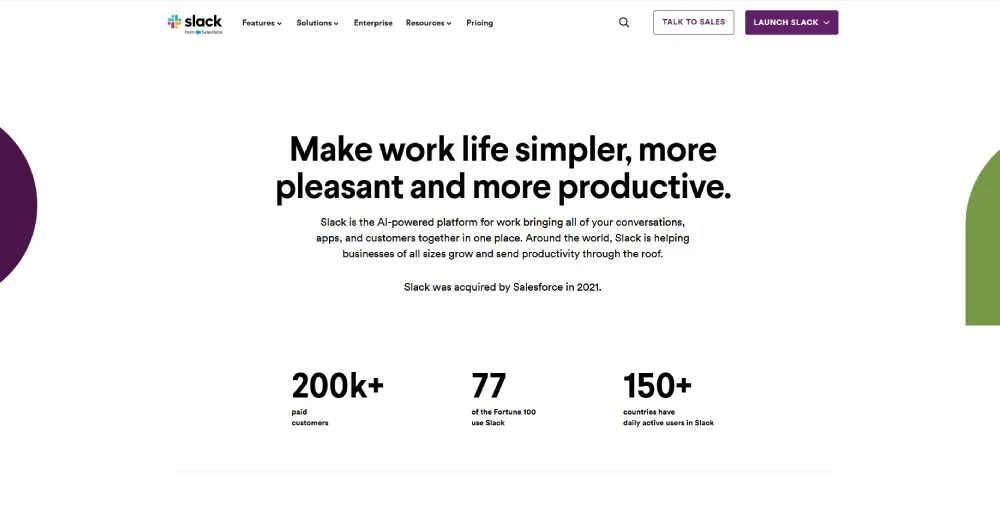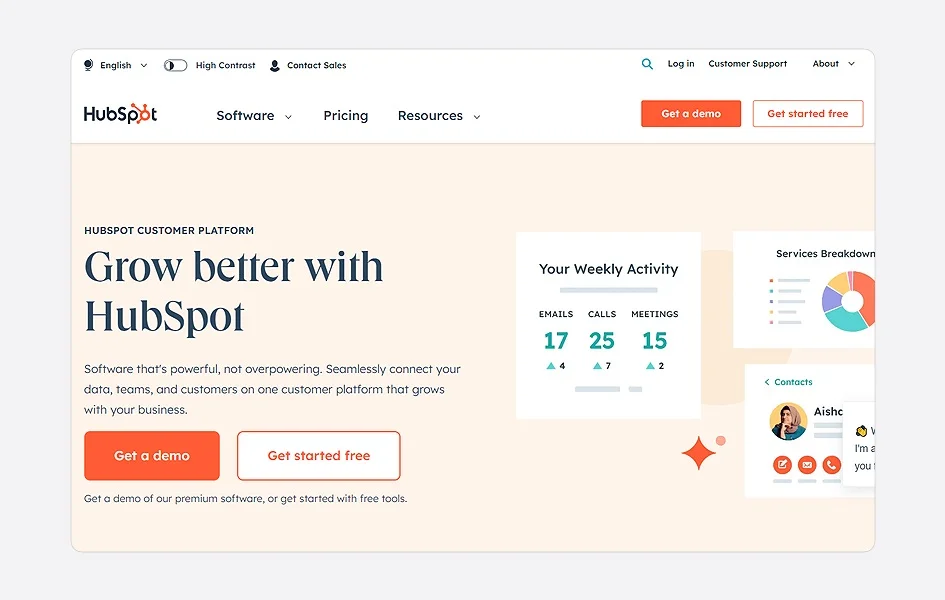The business world is more competitive today than ever before. Whether you run a large or small company, you need to stand out. Communicating well with your customers will help you outperform your competition while developing great products and services. You need to show the value of your company, products, and services to get the best results from your marketing.
That’s why a strong value proposition is important. It shows your specific product and what you can offer to your customers. A clear value proposition can increase sales, improve marketing, and grow revenue.
In this blog, we’ll explain what a value proposition is and provide some of the best examples to help you create a strong message that can improve your marketing and attract more customers.
🔑 KEY HIGHLIGHTS
- A value proposition is a statement that suggests why customers should choose your product or service.
- A strong value proposition clearly shows what a company offers to its target audience and why it is the best choice.
- A successful value proposition should convince prospects to become paying customers.
- To write a good value proposition, you need to understand customer pain, identify and clear out your business benefit, match your value with customers, and explain why your business is different than other providers.
What is a Value Proposition?
A value proposition is a sentence or paragraph that clearly explains what your business service does, who it brings value to, and why it is valuable to customers. In other words, it is a statement that summarizes why the target audience should choose your products or services.
Many companies use this statement to target customers who will benefit from purchasing their product or service. This helps maintain a company’s economy.
A value proposition should clearly explain how your product fulfills the customer’s need, its benefits, and why it’s better than similar products on the market. It should be clear why customers should choose your company over the other company and why you’re the best choice.
Moreover, a value proposition is an important factor that can make a huge difference in sales and closing deals for the company. If you cannot show value to your customers and tell them why they should choose you over someone else, you have no chance of competing in the market. So, businesses need to create one value proposition statement that represents their products and services.
What Makes a Good Value Proposition?
A good value proposition always fulfills the needs of customers that other companies couldn’t. It offers unique solutions or services unavailable from competitors, focusing on connecting customer needs with the seller’s solutions. It highlights the specific problem that the company solves, the advantages it provides, and why it is superior to its competitors.
A good value proposition helps differentiate a business and attract customers by effectively addressing their needs and pain points. Hence, it should serve as a brand promise. A promise that assures the buyer that your company’s solution offers clear benefits (and value) in exchange for their investment.
Furthermore, a value proposition statement is also about how clearly you can make your buyer understand the service you provide. You cannot reach the customer if you cannot comprehend your business idea. So, your value proposition should always be clear and easy to understand.
Lastly, it should also provide customers with detailed information about the outcomes they can expect from using the product or service.
Components of a Value Proposition
Your value proposition is usually displayed on your website. While you can also include it in marketing campaigns and brochures, the most prominent place is your website homepage and, if desired, your product pages.
A value proposition has three main parts: the headline, the subheadline, and a visual element.
- Headline: The headline describes the benefits customers will get from buying your product or service. Ideally, it should be clear, concise, and a single memorable sentence or phrase. Often, it includes a catchy slogan that can be part of a successful advertising campaign.
- Subheadline or Paragraph: The subheadline or paragraph provides more detail about what your company offers, who it serves, and why. It elaborates on the headline, typically in a short paragraph of two to three sentences. This section highlights your product’s key features or benefits, sometimes using bullet points to clarify the standout details.
- Visual Element: Sometimes, a visual element like a video, infographic, or image can communicate your value proposition better than words alone. These visuals can capture your audience’s attention and enhance your message. Companies often use market research to determine which messages and visuals resonate best with their customers, ensuring they create a strong value proposition.
What is the Purpose of a Value Proposition?
The purpose of a value proposition is to maintain and differentiate the company from others and tell customers what they can expect from their products or services. This helps your business differentiate from competitors and attract or retain customers.
A value proposition tells busy shoppers why they should choose your brand and your specific product. It quickly explains the benefits they’ll get, which can be helpful in a world where people have many choices. Similarly, it helps your team understand what your brand stands for and how it’s different. This helps when creating new products, running ads, or updating your website, and it keeps everyone focused on the same goal.
Finally, when you deliver on what your value proposition promises, customers trust your brand more. This makes them more likely to stick around and keep coming back. In short, a good value proposition helps you attract customers, keeps your team on track, and builds trust for the long term.
How to Write a Value Proposition?

A well-written value proposition efficiently tells customers why your product or service is the best on the market. A concise statement should distinguish your company from the competition and tell people what benefits you provide over the alternatives.
1. Understand and Identify Customer’s Pain
Understanding and identifying customers’ pain and troubles requires extensive research. So, before making any value proposition, talk to your customer service reps, marketing specialists, and salespeople to understand what problems your customers are looking to solve by using your product or service.
For example, let’s say your business sells virtual phone numbers. Your ideal customer is someone looking for an affordable and flexible phone to contact people living abroad. In this case, your business should create a good value proposition and offer the necessary solution.
2. Identify the Benefits and Explain Your Value
Now that you have some knowledge about your customer’s pain and the solutions they need start creating a list of your company’s products and services. Try to describe these products in one sentence and explain how you can provide the service that customers need.
This is a crucial step as you have to list every product you sell and describe its primary benefit.
When evaluating your draft, ensure it answers the following questions:
- What product are you selling?
- Who should buy your product?
- How will buying your product improve the visitor’s life?
- Why should the visitor buy from you and not your competitors?
- When will the value be delivered?
Your value proposition should be short, including two or three sentences maximum.
3. Match Your Value to Customer Pain
After understanding the customer’s pain and the values you offer, you now have to pair the buyer’s problem with your business value. Do they align? Do you have something that solves the customer’s problem? If so, then start refining your value proposition and differentiate your benefit from the competition.
If they don’t align, just follow the above steps and tips until you find a buyer who needs your business’s solution.
4. Explain Why Your Business Is Different Than Other Providers
Explain what makes your business or service different from competitors and try to polish your value proposition. Companies should address questions such as: Do you provide a service that others don’t? Do you offer any additional services that other companies charge for? Is your product or service more affordable than others?
These elements can help differentiate your value proposition from competitors while keeping the focus on the buyer’s needs.
5. Using different template
Even if you cannot create your own effective value proposition, there are some templates you can try.
A. Steve Blank Method
Former Google employee Steve Blank created a simple template for companies to describe their benefits in one sentence: “We help (X) do (Y) by doing (Z).” This means a company should clearly state who it helps, what it helps them achieve, and how it does it.
B. Geoff Moore Method
Marketing consultant Geoff Moore developed a value proposition method used by many Fortune 500 companies: “For (target audience) who (need or opportunity), our (product/service name) is (product category) that (benefit).” For example, For parents whose kids don’t get up on time, our Eject-a-Bed is functional furniture that works with the push of a button. This method clearly identifies the customer, their need, the product, and the benefit.
C. Harvard Business School Method
Harvard Business School suggests that a good value proposition should answer these questions:
- What is my brand offering?
- What job does the customer hire my brand to do?
- What companies and products compete with my brand to do this job for the customer?
- What sets my brand apart from competitors?
This approach helps a company define its offering, understand its customers’ needs, recognize its competition, and highlight its unique advantages.
Value Proposition Examples
Many companies have their own written value proposition. Here are five value proposition examples;
1. Slack- “Simple and Easy-to-Use Collaboration Tools for Team”
Headline: “Make work life simpler and more efficient.”
Subheadline/Paragraph: An AI platform that brings your conversations, apps, and customers together in one place.
Visual Element:

Slack is simple and easy-to-use software that helps teams collaborate instantly. This platform allows a team to create a group for different projects or departments, share files, exchange messages, and more. Slack’s value proposition is to make work happen simpler, easier, faster, and more efficient.
Slack aims to target a large company with hundreds of employees who are tired of switching apps just to communicate properly with the team members. These users want a system that makes their work simpler and easier. And that’s precisely what Slack does.
2. HubSpot: “An Easy-to-Use CRM.”
Headline: “An easy-to-use CRM”.
Subheadline/Paragraph: “HubSpot’s CRM platform offers tools and integration that you need
for marketing, sales, content management, and customer service.”
Visual Element:

HubSpot is a leading customer relationship management (CRM) software; many companies can benefit from it. Its simple and user-friendly CRM features help users maximize business growth. HubSpot’s value proposition is to target CRM users who want a highly scalable and feature-rich system.
Individuals and teams can gain actual benefits from using HubSpot for each product. Using HubSpot’s compatible and easy tools, businesses can manage all their marketing, sales, content, and customer service needs in one place.
3. Pipedrive “The Easy and Effective CRM for Closing Deals.”
Headline: “The easy and effective CRM for closing deals.”
Subheadline/Paragraph: Pipedrive lets you track your sales pipeline, manage leads, and automate your entire sales process in one place so you can focus on selling.
Visual Element:
The right CRM system can make your work easy and hassle-free. In its value proposition, Pipedrive aims to target a business that wants to simplify its workflow and provide personalized tips to help it focus on winning deals.
Pipedrive isn’t just CRM software that wants to sell you a bunch of plans, which isn’t exactly necessary for your business. It offers a flexible CRM to match your needs. It has different tiers of highly customizable integration, making it one flexible choice for small businesses.
4. Zapier “Join Millions Who Automate Their Work Using Zapier.”
Headline: Join millions who automate their work using Zapier.
Subheadline/Paragraph: Workflow automation for everyone. Zapier automates your work across 6,000+ app integrations, so you can focus on what matters.”
Visual Element:

Zapier’s value proposition targets businesses that want to connect their apps or services to other apps to automate repetitive tasks without coding or relying on developers to build the integration. With Zapier, the software can pass info between your apps with workflows called Zaps.
Zapier offers integration for over 7,000 apps, including Google Docs, Slack, KrispCall, Salesforce, and many more. With a few clicks, you can link your web apps and share data. Moreover, it lets you move between apps and automate repetitive tasks.
5. Zoom: “Enhance workplace productivity with AI companion.”
Headline: “Enhance workplace productivity with AI companion.”
Subheadline/Paragraph: Streamline communication, increase employee engagement, and improve productivity with Zoom workplace fueled by Zoom AI companion.
Visual Element:

Zoom has three value propositions: accessibility, performance, and brand/status. It provides accessibility by offering a variety of options, such as video conferencing, group messaging, simple online meetings, and a software-defined conference room feature.
Since Zoom is a people-centric cloud service, it transforms the real-time collaboration experience and improves the quality and effectiveness of communications.
Types of Value Propositions
There are three types of value propositions: brand value proposition, product value proposition, and category value proposition. Each type has its own way of promoting and building connections with customers.
1. Brand Value Proposition
This type focuses on the benefits customers will receive from associating with the brand. For example, a brand might promise to create a customer-friendly platform. Customers who care about their value will feel a personal connection to the brand. The brand value proposition is about creating a positive perception of the brand and encouraging customer loyalty and trust.
2. Product Value Proposition
This type is centered on the product itself. The company explained how using the product would help customers’ daily lives. It’s about creating a strong link between the product and the customer’s needs or desires. For example, a smartphone brand might emphasize its product’s long battery life and high-quality camera to show customers how these features can enhance their daily activities.
3. Category Value Proposition
When a company wants to highlight a specific product category, it develops a value proposition for that category and communicates it to the target market. If the message resonates with the customers, it can boost sales for that category. For instance, a company that sells sports equipment might focus on promoting its range of running shoes, focusing on features like comfort and durability to attract serious runners. If successful, this can lead to increased sales within that particular category.
Conclusion
A clear and simple value proposition is essential for any business wanting to succeed in today’s competitive market. It explains why your product or service is valuable and why customers should choose you over others.
A strong value proposition helps you attract and keep customers, guides your team, and supports your company’s goals. To create one, understand what your customers need, describe the benefits of your product, and show how it solves their problems better than other options.
An effective value proposition makes it easy for customers to see why your brand is the best choice, leading to more sales and customer loyalty. Using straightforward methods and templates can help you make a message that connects with your audience and helps your business grow.





